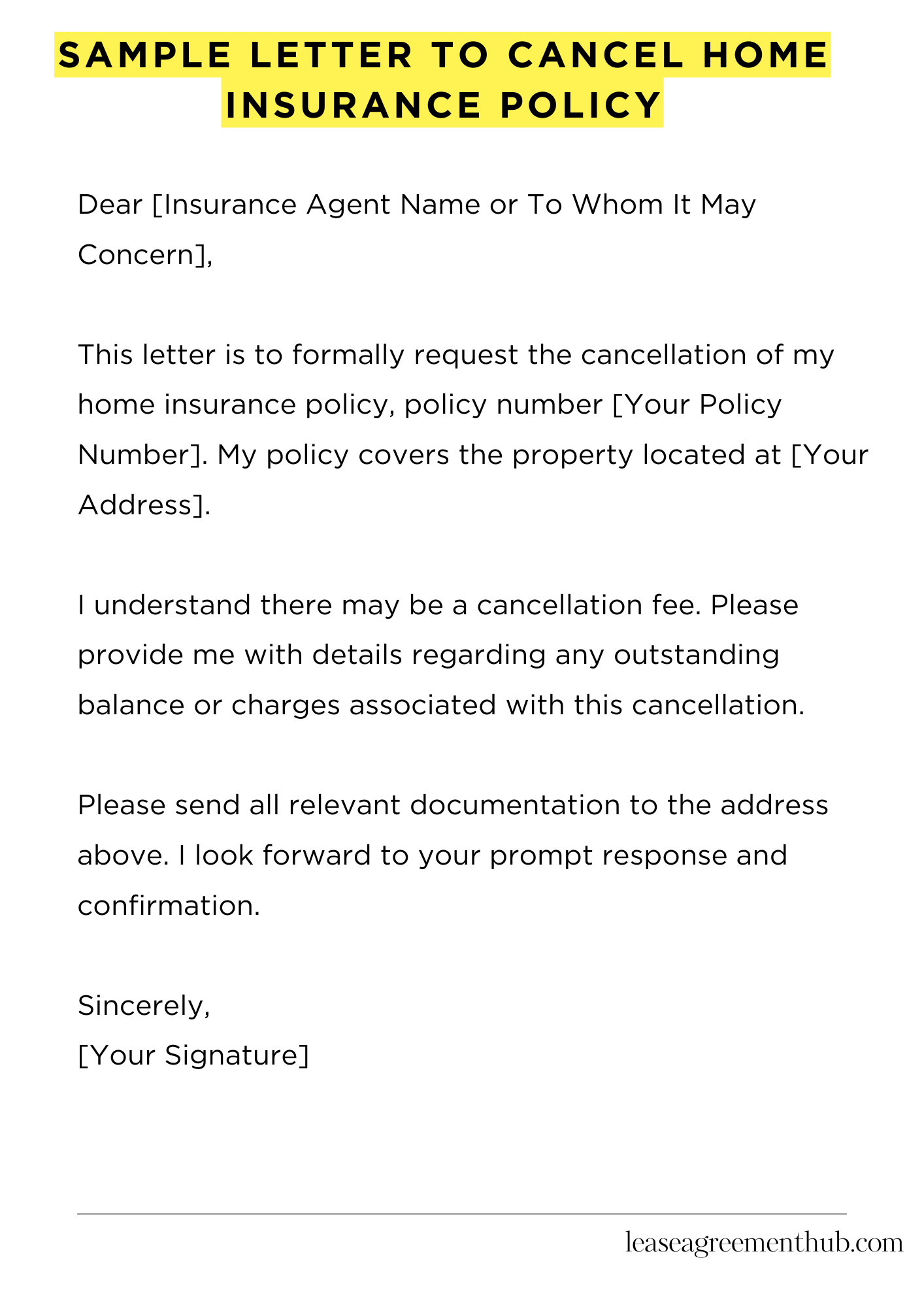A sample letter to cancel your home insurance policy is a pre-written example. It helps you write your own cancellation letter. It saves you time and effort.
This article gives you several sample letters. They are ready-to-use templates. You can adapt them to your situation.
These samples make writing your cancellation letter easy. They provide a clear and professional format. You will easily cancel your policy.
Sample Letter to Cancel Home Insurance Policy
[Your Name]
[Your Address]
[Your Phone Number]
[Your Email Address]
[Date]
[Insurance Company Name]
[Insurance Company Address]
Dear [Insurance Agent Name or To Whom It May Concern],
This letter is to formally request the cancellation of my home insurance policy, policy number [Your Policy Number]. My policy covers the property located at [Your Address].
The reason for cancellation is [Clearly state your reason. Be brief and factual, e.g., “I have sold my home,” or “I am moving and have secured alternative insurance coverage,” or “I no longer require home insurance coverage.”].
I understand there may be a cancellation fee. Please provide me with details regarding any outstanding balance or charges associated with this cancellation. I would appreciate a confirmation of the cancellation date and a final statement showing any refund owed.
Please send all relevant documentation to the address above. I look forward to your prompt response and confirmation.
Sincerely,
[Your Signature]
How to Write a Sample Letter to Cancel Home Insurance Policy
Understanding the Nuances of Cancellation
Cancelling your home insurance policy isn’t as simple as ripping up the paperwork. It requires a formal, written request. Ignoring the process can lead to unforeseen financial repercussions; hence, a meticulously crafted cancellation letter is paramount. This isn’t merely a casual note; it’s a legally significant document. Precision is key.
Gathering Essential Information: A Proactive Approach
Before you even begin composing your letter, gather all the necessary details. This includes your policy number (a crucial identifier), the effective date of cancellation, and the reason for cancellation. Having this information readily available streamlines the process and ensures a swift, uncomplicated cancellation. Don’t overlook even seemingly trivial details; complete accuracy is paramount.
Structuring Your Cancellation Letter: A Formal Approach
Your letter should follow a formal business letter format. Begin with your contact information, followed by the insurer’s address. Use a professional salutation—avoid colloquialisms. State your intention clearly and concisely in the opening paragraph. A succinct and unambiguous request is crucial. The body should elaborate on the aforementioned details. Conclude with a polite closing and your signature.
Crafting Compelling Content: Clarity is King
The text of your letter should be lucid and unambiguous. Avoid jargon and convoluted phrasing. Clearly state your desire to cancel the policy, providing the pertinent policy number and the desired cancellation date. If you have a specific reason for cancellation—such as moving or finding a better rate—include that information. Brevity and clarity are essential attributes.
Proofreading and Reviewing: The Final Bastion
Before sending your letter, meticulously review your work. Accuracy is of the utmost importance. Typos and grammatical errors can obfuscate your message and potentially delay the process. A fresh pair of eyes can be invaluable in spotting any oversights. Consider printing a copy for your records.
Choosing Your Delivery Method: Expediency and Documentation
Send your cancellation letter via certified mail with return receipt requested. This provides irrefutable proof of delivery, protecting you from any future disputes. Retain a copy of the letter and the return receipt for your files. Electronic delivery might be permissible, but certified mail offers superior evidentiary weight.
Post-Cancellation Procedures: Vigilance is Paramount
After sending your letter, follow up with the insurer to confirm receipt and the effective cancellation date. Request confirmation in writing to avoid any ambiguity. Review your final bill carefully to ensure it accurately reflects the cancellation. Proactive vigilance minimizes the risk of unexpected charges.
FAQs about sample letter to cancel home insurance policy
Cancelling your home insurance policy requires careful communication with your provider. A well-written letter ensures a smooth process and avoids potential issues.
What information must be included in a home insurance cancellation letter?
Your cancellation letter should include your full name, policy number, the effective date of cancellation, your reason for cancellation (if you wish to share it), and your contact information (address, phone number, and email). It’s also beneficial to request confirmation of cancellation in writing.
When should I send my home insurance cancellation letter?
The ideal time to send your cancellation letter depends on your policy’s terms and conditions. Many policies specify a notice period (e.g., 30 days) before cancellation takes effect. Sending the letter well in advance of your desired cancellation date is crucial to avoid penalties or gaps in coverage.
What is the best way to send my home insurance cancellation letter?
While email is convenient, it’s generally advisable to send your cancellation letter via certified mail with return receipt requested. This provides proof of delivery and helps ensure your insurer receives your request. Always keep a copy of the letter for your records.
What if I have already paid my premium for the current policy period?
If you cancel your policy mid-term, you may be entitled to a partial refund of your premium. This is determined by your policy’s terms and your insurer’s refund policy. Your letter should mention your expectation of a refund and inquire about the process.
Can I use a sample letter, or do I need to write my own?
Using a sample letter can be a helpful guide, providing a framework for the necessary information. However, it’s important to personalize the letter with your specific details and policy information. Reviewing the sample letter and adapting it to your situation is the recommended approach.
Related: